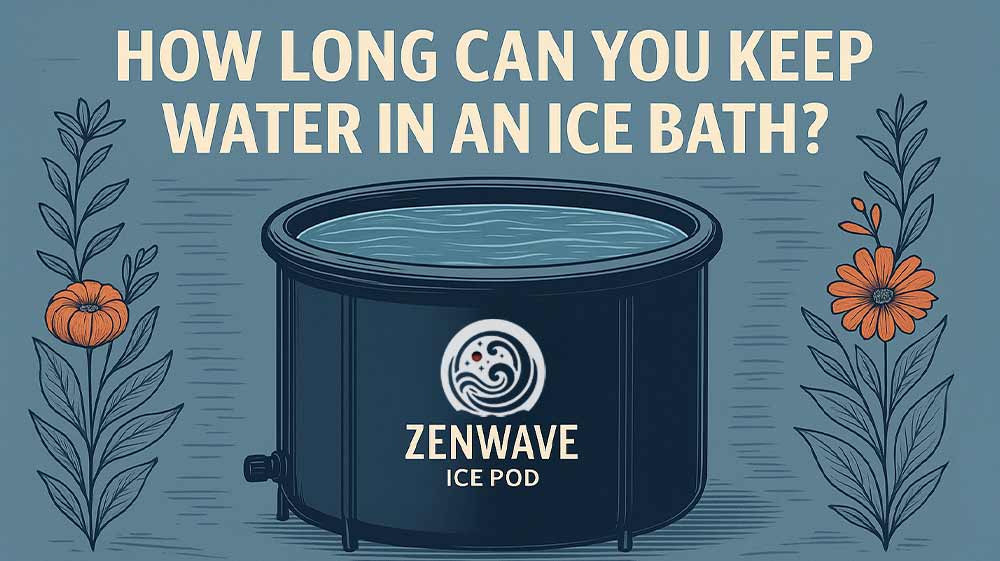How long you can keep water in an ice bath depends on your setup, usage, and maintenance habits. Getting it right means avoiding smelly, cloudy, or bacteria-filled water that not only ruins your plunge—but can put your health at risk. This guide covers how long ice bath water lasts and exactly what to do to keep it clean for as long as possible.
The short answer? Anywhere from 2 days to 2 months — depending on your setup and how well you maintain it.
Let’s break it down so you know when to change the water and how to keep it fresh longer.
Quick Answer: Average Water Lifespan
| Setup Conditions | Water Lifespan |
|---|---|
| No lid, no rinse, no filter | 1–3 days |
| Lid + rinse + peroxide | 5–7 days |
| Lid + rinse + filter + peroxide | 10–21 days |
| High-end chiller + UV + full care | 1–2 months (with regular upkeep) |
These are estimates. Actual lifespan depends on cleanliness, treatment, and usage habits.
What Makes Water Go Bad?
Even crystal-clear water turns quickly if you’re not careful. Here’s what causes water to degrade:
- Body contaminants: Sweat, oils, dead skin, deodorant, lotion.
- Environmental debris: Dust, pollen, bugs, and rain (especially outdoors).
- Microbial growth: Algae, bacteria, and fungi thrive in stagnant, untreated water.
If you’re not actively maintaining your setup, expect cloudy water, a sour smell, and slimy buildup — all signs it’s time to change it.
Factors That Determine How Long You Can Keep Water
1. How Clean You Are Before You Get In
Rinsing off before each plunge is the #1 way to keep your water clean longer. Skipping this step introduces body oils, sweat, and bacteria that rapidly degrade water quality. Learn more in our guide on showering before an ice bath.
2. Frequency and Number of Users
- Solo use = longer lifespan
- Daily use = moderate lifespan
- Multiple people or back-to-back plunges = short lifespan (3–5 uses max without treatment)
3. Lid vs No Lid
A lid reduces exposure to UV (which causes algae), debris, bugs, and rain. No lid? Expect to change water every 2–4 days.
4. Filtration & Treatment
No treatment? Water will last just a few uses. Add hydrogen peroxide (1–2 cups of 3% solution every few days for every 100 gallons) and install a filter or chiller and you’ll extend usability drastically. Consider one of the best water chillers for ice baths to simplify long-term maintenance.
5. Indoor vs Outdoor Setup
Outdoor tubs need more maintenance due to sun, rain, and wind-blown debris. Without a lid and consistent care, outdoor water can go bad in just 2–3 days.
What Happens If You Don’t Maintain Your Water?
- Cloudy appearance
- Sour, musty, or swampy smell
- Slimy walls (biofilm buildup)
- Algae or surface scum
- Skin irritation
Regular neglect also reduces cooling efficiency and increases wear on your gear. Here’s how pH imbalance and contamination impact water health.
How to Keep Ice Bath Water Clean Longer (Simple Framework)
| Action | Why It Matters |
|---|---|
| Rinse before every plunge | Reduces body-borne contaminants |
| Use a tight-fitting lid | Keeps out bugs, pollen, rain, and algae |
| Add 3% hydrogen peroxide | Natural disinfectant, no chlorine smell |
| Install a filter or chiller | Circulates and purifies the water |
| Wipe down surfaces weekly | Stops biofilm and grime buildup |
| Change water every 2–4 weeks | Even with all the above — still vital |
8 Steps to Maximize Water Lifespan
1. Change Water Every 2–4 Weeks
This is your baseline. Even with the best maintenance, water should be replaced periodically.
2. Deep Clean the Tub Monthly
Use a vinegar-water solution or non-abrasive cleaner. Scrub corners and seams. Rinse thoroughly.
3. Add Sanitizer Regularly
- Hydrogen peroxide (3%): 1–2 cup per 100 gallons every few days. Here’s a full walkthrough on how to use hydrogen peroxide safely in ice baths.
- Optional: Chlorine or bromine (less common for natural users)
4. Use Filtration or Circulation
- Chiller systems with built-in filters = best performance
- Ozone or UV treatment = kills bacteria, no chemicals
- DIY pump + paper filter = budget-friendly option
A filtration system makes a big difference. Whether it’s a built-in chiller filter, ozone, or a budget-friendly pump setup, circulation improves clarity. Here’s a guide to DIY ice bath filtration.
5. Monitor and Adjust pH
Keep your pH between 7.2 and 7.6. This boosts sanitizer effectiveness and protects your skin and equipment.
6. Rinse Off Before Every Use
Avoid lotions, deodorants, or oils before plunging. Shower with plain water to reduce contamination.
7. Skim Debris Daily
Use a skimmer net before and after each plunge.
8. Keep It Covered
A lid is your best passive defense against outdoor contamination and algae.
Full guide: how to keep your ice bath water clean
Weekly Water Care Routine
Daily
- Rinse before plunging
- Skim debris
- Check sanitizer level
Weekly
- Test pH, adjust if needed
- Wipe walls with sponge or brush
- Partial water change (10–15%)
Monthly
- Full drain and scrub
- Clean filter
- Inspect equipment
Quarterly
- Replace water fully (even if treated)
- Deep clean and sanitize entire setup
Final Thoughts
If you’re serious about cold therapy, you should be serious about water care. Most issues are avoidable with a basic routine.
Whether you’re running a DIY setup or a high-end filtered system, a clean tub makes your plunge safer, smoother, and more enjoyable.
Take 5 minutes a day to maintain it — your skin, tub, and nose will thank you.

